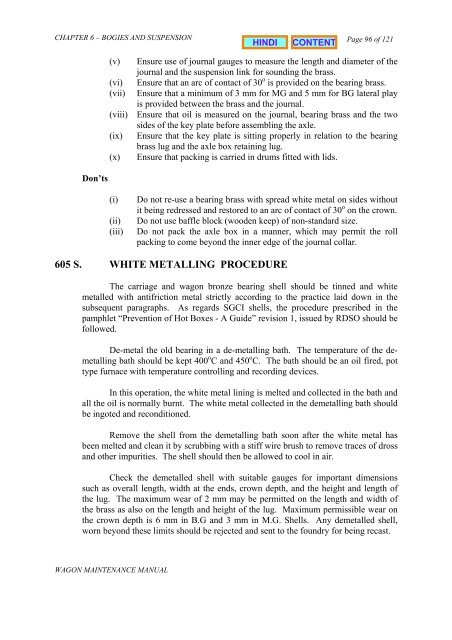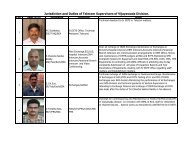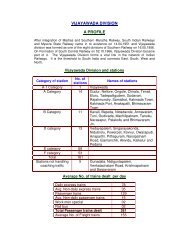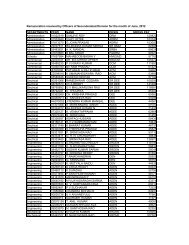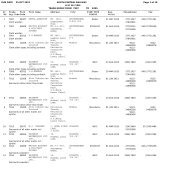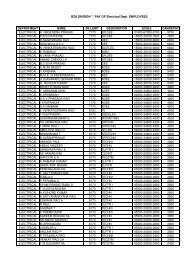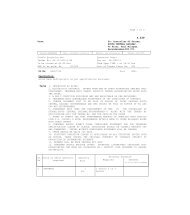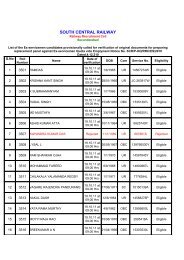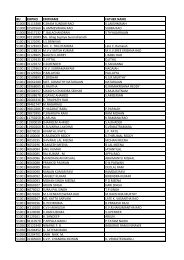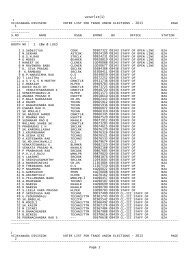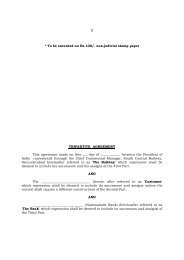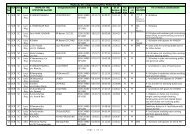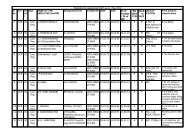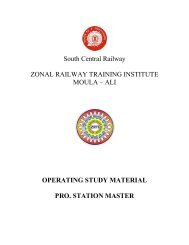BOGIES AND SUSPENSION - South Central Railway
BOGIES AND SUSPENSION - South Central Railway
BOGIES AND SUSPENSION - South Central Railway
Create successful ePaper yourself
Turn your PDF publications into a flip-book with our unique Google optimized e-Paper software.
CHAPTER 6 – <strong>BOGIES</strong> <strong>AND</strong> <strong>SUSPENSION</strong><br />
Don’ts<br />
WAGON MAINTENANCE MANUAL<br />
Page 96 of 121<br />
(v) Ensure use of journal gauges to measure the length and diameter of the<br />
journal and the suspension link for sounding the brass.<br />
(vi) Ensure that an arc of contact of 30 o is provided on the bearing brass.<br />
(vii) Ensure that a minimum of 3 mm for MG and 5 mm for BG lateral play<br />
is provided between the brass and the journal.<br />
(viii) Ensure that oil is measured on the journal, bearing brass and the two<br />
sides of the key plate before assembling the axle.<br />
(ix) Ensure that the key plate is sitting properly in relation to the bearing<br />
brass lug and the axle box retaining lug.<br />
(x) Ensure that packing is carried in drums fitted with lids.<br />
(i) Do not re-use a bearing brass with spread white metal on sides without<br />
it being redressed and restored to an arc of contact of 30 o on the crown.<br />
(ii) Do not use baffle block (wooden keep) of non-standard size.<br />
(iii) Do not pack the axle box in a manner, which may permit the roll<br />
packing to come beyond the inner edge of the journal collar.<br />
605 S. WHITE METALLING PROCEDURE<br />
The carriage and wagon bronze bearing shell should be tinned and white<br />
metalled with antifriction metal strictly according to the practice laid down in the<br />
subsequent paragraphs. As regards SGCI shells, the procedure prescribed in the<br />
pamphlet “Prevention of Hot Boxes - A Guide” revision 1, issued by RDSO should be<br />
followed.<br />
De-metal the old bearing in a de-metalling bath. The temperature of the demetalling<br />
bath should be kept 400 o C and 450 o C. The bath should be an oil fired, pot<br />
type furnace with temperature controlling and recording devices.<br />
In this operation, the white metal lining is melted and collected in the bath and<br />
all the oil is normally burnt. The white metal collected in the demetalling bath should<br />
be ingoted and reconditioned.<br />
Remove the shell from the demetalling bath soon after the white metal has<br />
been melted and clean it by scrubbing with a stiff wire brush to remove traces of dross<br />
and other impurities. The shell should then be allowed to cool in air.<br />
Check the demetalled shell with suitable gauges for important dimensions<br />
such as overall length, width at the ends, crown depth, and the height and length of<br />
the lug. The maximum wear of 2 mm may be permitted on the length and width of<br />
the brass as also on the length and height of the lug. Maximum permissible wear on<br />
the crown depth is 6 mm in B.G and 3 mm in M.G. Shells. Any demetalled shell,<br />
worn beyond these limits should be rejected and sent to the foundry for being recast.


